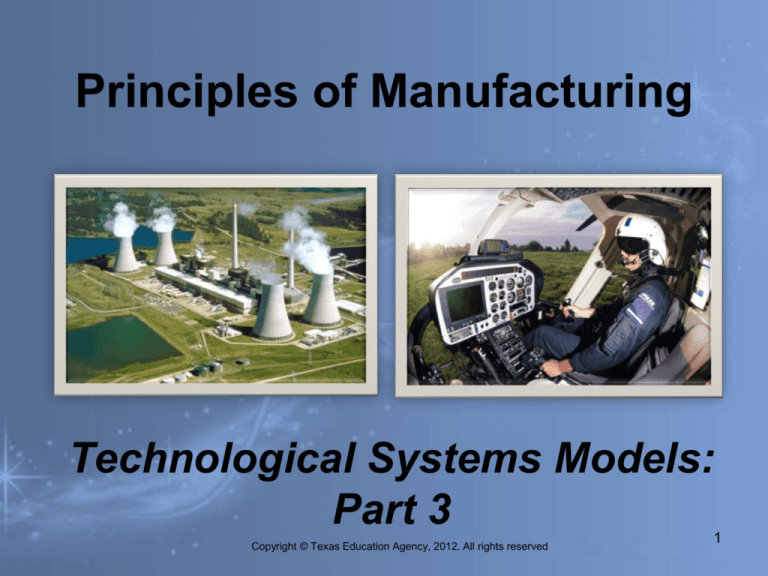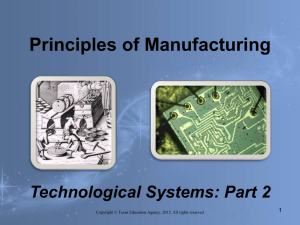
Principles of Manufacturing
.
Technological Systems Models:
Part 3
Copyright © Texas Education Agency, 2012. All rights reserved
1
Bell Work Activity
Directions: Please take out a sheet of paper
and answer the following questions.
A. In your opinion which method of travel is safer, automobiles
or airplanes? Why do you think so?
B. When was the last time you experienced an electrical power
outage? List 5 of the things you did to take the place of
electricity.
C. If you were planning a camping trip (not in a recreational
vehicle), list 10 essential items you would want to take.
Copyright © Texas Education Agency, 2012. All rights reserved
2
Warm-Up Activity
Engineering and Technology Terms
A. There are several important terms and
definitions students need to know.
B. Students will now complete the Matching
Definitions handout on Technological Systems.
Students may work in groups.
Copyright © Texas Education Agency, 2012. All rights reserved
3
Manufacturing and Technological
Systems Models
Systems are designed to complete tasks
and produce outputs. Open and closed
loop systems are the most common basic
models.
A. Open Loop System
Input
Process
Output
Copyright © Texas Education Agency, 2012. All rights reserved
4
Manufacturing and Technological
Systems Models (continued)
B. Closed Loop System
Input
Process
Output
Feedback
Copyright © Texas Education Agency, 2012. All rights reserved
5
Understanding manufacturing
system processes
A. Lean Manufacturing
Is defined as waste elimination in the production process
while creating value*.
B. Supply Chain (Logistics) Systems
Systems designed to control the flow of production
materials to the right place at the right time.
Copyright © Texas Education Agency, 2012. All rights reserved
6
Understanding manufacturing
system differences
A.Lean Manufacturing versus traditional inventory
systems
Prior to Lean systems, previous high inventory systems
were costly, inefficient and prevented company growth.
B. Supply Chain Systems versus traditional supply
systems
Traditional supply systems were highly inefficient: difficulty
in tracking and accounting for high levels of inventory; poor
communication systems caused difficulty in understanding
demands; no global coordination.
Copyright © Texas Education Agency, 2012. All rights reserved
7
The Goal of Technological
Systems
A. Aircraft Systems- have evolved and been redesigned over the years to be safer and more reliable.
Hydraulics
Electrical
Fuel
Oxygen
Propulsion
Navigation
Ice protection
Flight controls
Copyright © Texas Education Agency, 2012. All rights reserved
8
The Goal of Technological
Systems
A. A nuclear power plant system creates the necessary
steam energy used to drive electrical generators through
the nuclear fission process (the splitting of an atom).
The fission process
The plant system model
Copyright © Texas Education Agency, 2012. All rights reserved
9
The Nuclear Plant System
Power output
Model
Containment structure
E
Cooling Tower
B
A
.
C.
D
A- Nuclear Reactor
B- Steam Generator
C-Turbine
D- Generator
E- Transformer
F- Water Supply
F.
Copyright © Texas Education Agency, 2012. All rights reserved
10
Nuclear Power
Copyright © Texas Education Agency, 2012. All rights reserved
11









